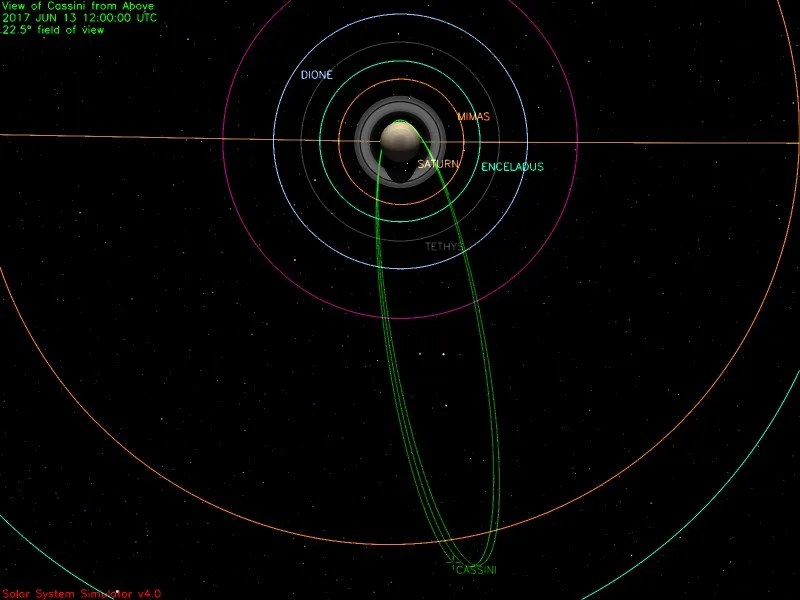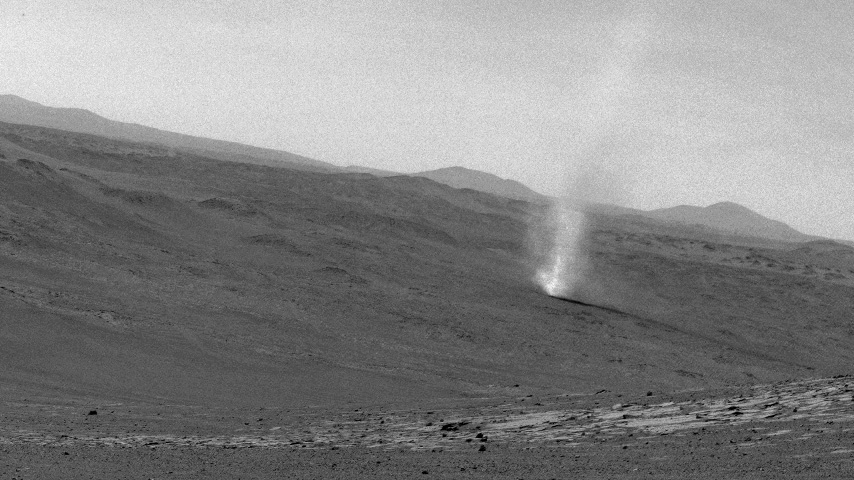
Cassini Significant Events 6/07/17 - 6/13/17
Cassini traveled from apoapsis to apoapsis this week, starting and completing its Orbit #278 of Saturn. From the top of its ellipse on Wednesday, once again it fell towards the ringed planet, gathering speed until on Saturday it whipped through another periapsis, interior to the planet's rings for the eighth time. Then it slowed while climbing out again to 1.3 million kilometers distance from the planet. As with each orbit, Cassini's view of the giant planet, its rings, its moons, and its magnetic field, changed dramatically during the week, and of course the spacecraft utilized every minute to make scientific observations, in between – and even during – engineering activities and communications sessions via the Deep Space Network (DSN). There are fourteen more full orbits of Saturn remaining in Cassini's extraordinary mission.
Wednesday, June 7 (DOY 158)
Cassini’s apoapsis passage came after completing a regular nine-hour communications session with the flight team by way of the DSN today. From that distance, the Composite Infrared Spectrometer (CIRS) made a six-hour observation, looking back "down" to the sunlit side of Saturn's C ring, from where it collected spectral signatures showing the ring particles' emissivity at thermal-infrared wavelengths. CIRS was taking advantage of the small ring-opening angle, since the spacecraft had just ascended through Saturn's equatorial plane.
Moons of the outer planets can be as diverse, and as fascinating, as planets in a solar system. This featured article offers the reader a tour of some of Saturn's natural satellites: /news/13069/a-tour-of-saturns-moons.
Thursday, June 8 (DOY 159)
Happy Birthday, Giovanni! Born this day in 1625, the Italian Giovanni Domenico Cassini became a mathematician, astronomer, and engineer. He held the astronomy chair at the University of Bologna, until being recruited to help set up the Paris Observatory in 1669; he became a naturalized citizen of France at age 48. With the extraordinary telescopes he implemented, Cassini studied the fascinating planet Saturn, and promptly discovered four of its moons (two of which are toured in the article linked above). In 1675, he noted the division between Saturn's A Ring and B Ring that is now known as the Cassini Division. Cassini directed the Paris Observatory until he died, at age 87.
Saturn is well placed for viewing in any telescope these evenings. It rises shortly following sunset, and appears as a creamy-white object towards the south, twinkling much less than the stars do, as it moves from east to west through the night. The rings are tilted wide-open towards Earth, making the display quite memorable.
Saturn's largest moon Titan completes its nearly circular orbits of Saturn once every 15.95 days, and Cassini takes 6.5 days to complete its highly elliptical orbits. Once in a while they still meet up of course, and today they approached one another at a distance a little less than that between Earth and our own Moon. The Imaging Science Subsystem (ISS) and CIRS began a 27.9-hour series of observations, each taking turns examining the planet-like moon's surface and its weather. When CIRS was the prime observer, ISS and the Visible and Infrared Mapping Spectrometer (VIMS) rode along, and when ISS was in the driver's seat CIRS and VIMS were the riders. Northern summer is now upon the Saturn system, and these observations continue to monitor the effects of seasonal change on Titan.
In an article featured today, we read about Cassini's trip to Saturn from a recent interview with the Cassini Program's original Mission and Science Design manager: /news/13070/scenic-route-to-saturn.
Friday, June 9 (DOY 160)
Cassini rotated to face its four-meter wide high-gain radio dish to Earth, which it would track through space for the next 53.5 hours. Based on the stable radio-frequency reference signal Cassini was receiving from the DSN continuously for this period, the spacecraft generated its own stable-frequency downlink transmission for the duration.
This was the final day in the week-long 72nd Cassini Project Science Group (PSG) meeting in Noordwijk, the Netherlands, at the European Space Research and Technology Centre (ESTEC).
Saturday, June 10 (DOY 161)
Today was a busy day for science. Cassini powered on its Radio Science transmitters at S-band (2 GHz) and Ka-band (32 GHz) frequencies, to go along with its normal X-band (8 GHz) downlink. On Earth, the Cassini Radio Science team used six DSN stations and two ESA stations to observe the Doppler shifts in Cassini's continuous signals, which the team will translate into fine measurements of Saturn's gravitation, thereby mapping the distribution of mass in the planet and its rings. A Radio Science Ring Occultation experiment was also executed, during which the team watched Cassini's radio beams as they actively probed Saturn's rings. The team recorded the attenuation, the scattering, and the other effects that the rings imposed on the radio signals, to learn more about the rings' structure and makeup.
During the Radio Science experiments, Cassini dove for the eighth time through the ring plane in between rings and atmosphere. It passed periapsis in its orbit #278 just a few minutes later. All the while, the Cosmic Dust Analyzer (CDA) rode along along to investigate various classes of particles in close to the planet.
Sunday, June 11 (DOY 162)
Viewing Saturn from "down under" on its dark side now, VIMS spent 8.7 hours mapping the giant planet's southern hemisphere, with CIRS and the Ultraviolet Imaging Spectrograph (UVIS) riding along for the first half. This will provide some of the highest-resolution maps of the south polar region obtained during the mission, with pixels spanning just over 300 km.
The day ended with ISS capturing a 12.6-hour observation of the icy plume that continuously spews from Saturn's small moon Enceladus Plume. CIRS, UVIS, and VIMS rode along.
Monday, June 12 (DOY 163)
VIMS spent three hours making a global map of Saturn, still observing the night side from south of the ring plane. Cassini's views of Saturn are often extraordinary. This graphic illustrates today's viewing geometry, which of course is never possible when viewing Saturn from Earth.
Mid-day today, UVIS began a three-day campaign of Saturn observations in the extreme- and far-ultraviolet parts of the spectrum. This included spectral-image scans of hydrocarbons such as acetylene and methane high in Saturn's atmosphere, as well as signatures of haze and cloud particles from scattered sunlight.
A recent view of Saturn's two-tone moon Iapetus is this week's featured image: /resources/17687.
Tuesday, June 13 (DOY 164)
The half-hour-long Operations Status and Coordination meeting has convened every Tuesday morning since the beginning of Cassini's flight. A designated science-planning engineer leads the meeting, and the conference room fills with representatives, either in person or on the telephone, from each of Cassini's many facets. Each participant listens to announcements, gives a status report, and hears the other participants' reports, for example, "The ISS instrument is nominal, and we have no ground issues. We will be taking 647 images in eight science observations this coming week. There have been 400,955 images obtained during the science mission." As the reports come in, any operational issues are triaged and picked up by the proper participants to resolve. Members each week include the spacecraft team, the navigation team, real-time operations, the DSN, and the dozen science teams. Then come reports from the developers of upcoming command sequences. Over the years, typically four 10-week sequences have been on the table: the sequence that is currently active on the spacecraft, and the status of three other sequences that are in their various stages of development. S100 is running now, and today there was only one sequence still in work: Cassini's final command sequence S101 is planned to go up on July 7, and begin executing on July 10.
Following the Ops Status and Coordination meeting on Earth, Cassini reached apoapsis in its circuit of Saturn. This marked the start of Orbit #279.
The DSN communicated with and tracked Cassini on 12 occasions this week, using stations in California, Spain, and Australia. European Space Agency (ESA) stations supported on three occasions, using stations in Australia and Argentina. A total of nine individual commands were uplinked, and about 2,365 megabytes of science and engineering telemetry data were downlinked and captured at rates as high as 142,201 bits per second.
Wrap up:
Cassini is executing its set of 22 Grand Finale Proximal orbits, which have a period of 6.5 days, in a plane inclined 62.0 degrees from the planet's equatorial plane. Each orbit stretches out to an apoapsis altitude of about 1,272,000 km from Saturn, where the spacecraft's planet-relative speed is around 6,000 km/hr. At periapsis, the distance shrinks to about 2,500 km above Saturn's visible atmosphere (by comparison, Saturn is about 120,660 km in diameter), and the speed is around 123,000 km/hr.
The most recent spacecraft tracking and telemetry data were obtained on June 14 using one of the 34-meter diameter DSN stations in California. The spacecraft continues to be in an excellent state of health with all of its subsystems operating normally except for the instrument issues described at http://saturn.jpl.nasa.gov/anomalies.
This illustration shows Cassini's path up to mid-day June 13: https://go.nasa.gov/2r8cKcV.
The countdown clock in Mission Control shows 93 days until the end of the Mission.
------------------------
This page offers all the details of the Mission's ending: <https://saturn.jpl.nasa.gov/mission/grand-finale/overview/>
------------------------
Milestones spanning the whole orbital tour are listed here:
<https://saturn.jpl.nasa.gov/mission/saturn-tour/tour-dates/>
------------------------
Information on the present position and speed of the Cassini spacecraft may be found on the "Present Position" page at:
<https://saturn.jpl.nasa.gov/mission/saturn-tour/where-is-cassini-now/>
------------------------
To unsubscribe from Cassini Spacecraft Updates or to subscribe with a different email address, visit:
<http://saturn.jpl.nasa.gov/news/mailinglistsignup/>
------------------------
For comments and questions, please contact Cassini Public Engagement at:
<http://saturn.jpl.nasa.gov/feedback/>
------------------------
This illustration shows Cassini's path up to mid-day June 13.



































